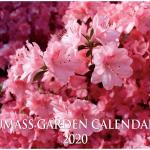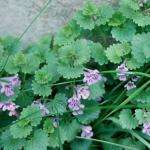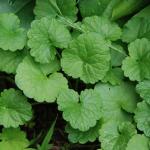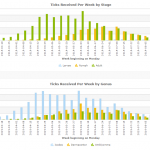A monthly e-newsletter from UMass Extension for landscapers, arborists, and other Green Industry professionals.
To read individual sections of the message, click on the section headings below to expand the content:
Hot Topics
Looking for a way to thank your clients this year?
Send them a 2020 UMass Extension Garden Calendar!
 For many years, UMass Extension has worked with the citizens of Massachusetts to help them make sound choices about growing and maintaining plants in their landscapes, including ornamental plants, backyard fruits and vegetables. Our 2020 calendar continues UMass Extension's tradition of providing gardeners with practical information. Featured this year is info on the care and cultural needs of rhododendrons and azaleas, some of the most popular choices for landscape plantings.
For many years, UMass Extension has worked with the citizens of Massachusetts to help them make sound choices about growing and maintaining plants in their landscapes, including ornamental plants, backyard fruits and vegetables. Our 2020 calendar continues UMass Extension's tradition of providing gardeners with practical information. Featured this year is info on the care and cultural needs of rhododendrons and azaleas, some of the most popular choices for landscape plantings.
Go to umassgardencalendar.org to see images from this year's calendar, online ordering, the chart for bulk discounts, and a printable order form.
As always, each month features:
* An inspiring garden image.
* Daily gardening tips for Northeast growing conditions.
* Daily sunrise and sunset times.
* Phases of the moon.
* Plenty of room for notes.
* Low gloss paper for easy writing.
Questions & Answers
Q: What is beech leaf disease?
A: Beech leaf disease (BLD) is a new threat to native and non-native beech (Fagus) in forest and landscape settings in our region. The disease is a caused by the nematode Litylenchus crenatae, which was only recently described as a new species from Japanese beech (Fagus crenata) in 2019. Nematodes are primarily microscopic roundworms and one of the most abundant animals on Earth. Most are free-living but some are parasites of other animals and plants. Nematodes are major pathogens of both agricultural crops and turfgrasses but cause relatively few diseases in woody plants.
BLD was first detected in Ohio in 2012 and it has since spread rapidly to nearby states and Canada. The disease was detected in Faifield County, Connecticut in 2019, raising concerns that the disease will soon spread into Massachusetts. When the nematode establishes in beech, symptoms first appear as dark green, interveinal bands in lower canopy leaves. Over time, the leaves become darkened, distorted and crinkled. Infections then spread into the upper canopy, resulting in dieback and decline. Most importantly, the nematode progresses into the buds, which are aborted and no new leaves are produced on the infected shoot. Based on initial observations in Ohio, trees infected by BLD die after several years.
Known hosts include American beech (F. grandifolia), European beech (F. sylvatica) and Oriental beech (F. orientalis), in addition to Japanese beech. The current evidence suggests that the nematode is non-native in North America. How the nematode has spread so quickly since it was introduced remains to be determined. American beech continues to suffer the devastating impacts of beech bark disease, caused by the fungal pathogen Neonectria. How this new threat will impact trees in natural and managed landscapes remains unknown but could dramatically reshape forests and landscapes with abundant beech populations.
Nicholas Brazee, UMass Extension Plant Pathologist
Trouble Maker of the Month
Adult Deer Tick – Second Peak Season!
As temperatures drop and we reach for our winter jackets and gloves, it may be easy to let our guard down when it comes to ticks. But do not be fooled into a false sense of security just because you had to defrost your windshield this morning! The UMass Laboratory of Medical Zoology reports a second peak season for adult deer ticks (Ixodes scapularis) in the fall, right around October 15th and lasting for at least a month beyond. They report as of 10/22/19 that they were receiving over 150 ticks per day to the TickReport lab!
The deer tick (also known as the blacklegged tick) is of medical importance as these nasty insect-relatives can carry and transmit the pathogens responsible for Lyme disease, human babesiosis, human anaplasmosis, and other diseases. Adult deer ticks remain active throughout the winter, whenever temperatures are above freezing. It is critical to be aware of this, and continue your daily tick prevention and tick-check activities throughout the winter if you are working in suitable tick habitats. Tick habitats include but are not limited to wooded, brushy, or grassy areas.
An Ounce of Prevention is Worth a Pound of Cure
Preventative activities, such as daily tick checks, wearing appropriate clothing, and permethrin treatments for clothing (according to label instructions) can aid in reducing the risk that a tick will become attached to your body. If a tick cannot attach and feed, it will not transmit disease. Here are some tips:
- Following any amount of time in tick habitat, check your entire body for ticks. Remove any attached ticks immediately with tweezers. The shower can be a good time/place to check for ticks. However, if they are attached, they will not rinse off – so don’t count on the spray of water to do the work for you!
- Wear light colored clothing that can be easier to spot crawling ticks on. Tuck pant legs into socks to stop any ticks crawling upwards from going up your pant leg. (It may not be fashionable, but isn’t it better than finding an attached, engorged tick later?)
- Treat footwear and socks with permethrin according to label instructions for safety and proper use. A URI study found that people wearing permethrin-treated sneakers and socks were 73.6 times less likely to have a tick bite than those wearing untreated footwear.
- Learn how to properly remove a tick: https://tickencounter.org/prevention/tick_removal
You’ve Removed an Attached Tick, What Do You Do?
Have you just removed an attached tick from yourself or a loved one with a pair of tweezers? If so, consider sending the tick to the UMass Laboratory of Medical Zoology to be tested for disease causing pathogens. To submit a tick to be tested, visit: https://www.tickreport.com/ and click on the blue “Order a TickReport” button. Results are typically available within 3 business days, or less. By the time you make an appointment with your physician following the tick attachment, you may have the results back from TickReport to bring to your physician to aid in a conversation about risk.
The UMass Laboratory of Medical Zoology does not give medical advice, nor are the results of their tests diagnostic of human disease. Transmission of a pathogen from the tick to you is dependent upon how long the tick had been feeding, and each pathogen has its own transmission time. TickReport is an excellent measure of exposure risk for the tick (or ticks) that you send in to be tested. Feel free to print out and share your TickReport with your healthcare provider.
Further Resources:
- For images of all deer tick life stages, along with an outline of the diseases they carry, visit: http://www.tickencounter.org/tick_identification/deer_tick .
- For more information about personal protective measures, visit: http://www.tickencounter.org/prevention/protect_yourself .
- For a quick overview of skin repellents available to protect yourself from ticks, visit “Tickology: Skin Repellents” by Larry Dapsis of Cape Cod Cooperative Extension: https://bit.ly/2J8IJBl .
- TickTalk with TickReport Webinar Series, archived webinars available here: https://ag.umass.edu/landscape/education-events/webinars
- Ticks and Tick-Borne Disease: https://ag.umass.edu/landscape/fact-sheets/information-regarding-ticks-tick-borne-diseases
Tawny Simisky, Extension Entomologist, UMass Extension Landscape, Nursery, & Urban Forestry Program
Plant of the Month
Ground ivy, Glechoma hederacea
Species characteristics
 Ground ivy is a member of the mint family, Lamiaceae (previously Labiatae). Ground ivy is also known as creeping Charlie, gill-over-the-ground, and, by some New Englanders, as robin-runaway or run-away-robin. This perennial weed reproduces by seed and creeping, prostrate stems that root at the nodes. Opposite leaves are round to kidney-shaped with round-toothed margins. Leaves are dark green with long petioles that arise from the creeping stems. Leaves are usually purplish is the spring during the flowering period. Flowering takes place in the spring; the bluish-purple flowers are two-lipped and funnel-shaped growing in axillary clusters. Flowers have a white throat with dark violet spots. While ground ivy is very shade tolerant, it can also be problematic is sunny turf and landscape areas. Ground ivy easily makes the list of “tough-to-manage” turf and landscape weeds.
Ground ivy is a member of the mint family, Lamiaceae (previously Labiatae). Ground ivy is also known as creeping Charlie, gill-over-the-ground, and, by some New Englanders, as robin-runaway or run-away-robin. This perennial weed reproduces by seed and creeping, prostrate stems that root at the nodes. Opposite leaves are round to kidney-shaped with round-toothed margins. Leaves are dark green with long petioles that arise from the creeping stems. Leaves are usually purplish is the spring during the flowering period. Flowering takes place in the spring; the bluish-purple flowers are two-lipped and funnel-shaped growing in axillary clusters. Flowers have a white throat with dark violet spots. While ground ivy is very shade tolerant, it can also be problematic is sunny turf and landscape areas. Ground ivy easily makes the list of “tough-to-manage” turf and landscape weeds.
Management Strategies
A two-pronged approach is usually recommended since ground ivy commonly occurs in both the turf and landscape areas on a particular site. Often when ground ivy is effectively managed in one setting, it will spread to another over time.
Landscape
As with all weeds, landscape mulch should be your first defense. At the first site of incursion, ground ivy can be treated with a directed-spray of glyphosate. Those seeking non-chemical control strategies can consider non-chemical products. These products are contact in nature and contain acetic acid, clove oil or orange extract, either singly or in combination. These products are not an effective choice for controlling perennial weeds, but since ground ivy does not reproduce by creeping roots, rhizomes or a taproot, they can be used for managing ground ivy.
Turf
Despite being considered one of the toughest turf weeds, management is relatively straightforward. The most active turf herbicide on ground ivy is triclopyr. Triclopyr is a common active ingredient in many broadleaf turf herbicide combinations. Some turf products contain triclopyr alone. The addition of dicamba to triclopyr or products that contain both triclopyr and dicamba are also good options. Applications of these products in the spring or summer will slow ground ivy but effective control will not be achieved. For the best control, products should be applied from mid-September to mid-October. Applications after mid-October can be done as long as ground ivy is still actively growing and green leaves are present. Turf areas containing large amounts of ground ivy and other weeds may require renovation following a broadcast application of glyphosate.


Upcoming Events
Fall Wrap-Up
November 21 - Join our UMass Extension Specialists for a look at the challenges and problems of the 2019 season and take advantage of this opportunity to earn your pesticide contact hours.
Location: The Publick House, Sturbridge, MA
Topics on woody ornamentals in the morning session include: Eastern White Pine Health and Other Woody Plant Diseases Observed in 2019; Managing Tough Landscape Weeds; and the Year In Review of Troublesome Insect and Mite Pests of Woody Plants.
Turf topics in the afternoon session include: Turf Weeds Your Program Is Likely To Miss; What We Saw In The Plant Diagnostic Lab in 2019; and Selecting Grasses to Reduce Pest Pressure and Pesticide Use.
Attendees can choose to attend either the morning or afternoon sessions, or the entire day.
CREDITS
ENTIRE DAY: 6 for Applicators License; 3 pesticide contact hours for categories 29, 36, or 37. Association credits: 3 ISA, 1 MCA, 2 MCLP, and 2 MCH.
Morning Session ONLY: 3 pesticide contact hours for categories 29, 36 or Applicators License. Association credits: 3 ISA, 1 MCA, 1 MCLP, and 1 MCH.
Afternoon Session ONLY: 3 pesticide contact hours for categories 37 or Applicators License. Association credits: 1 MCLP and 1 MCH.
Registration and Additional Information.
Other Upcoming Events:
- 11/21 - Fall Wrap-up
- 1/6-2/14 - Winter School for Turf Managers
For more information and registration for any of these events, go to the UMass Extension Landscape, Nursery, and Urban Forestry Program Upcoming Events Page.
Additional Resources
For detailed reports on growing conditions and pest activity – Check out the Landscape Message
For commercial growers of greenhouse crops and flowers - Check out the New England Greenhouse Update website
For professional turf managers - Check out Turf Management Updates
For home gardeners and garden retailers - Check out home lawn and garden resources. UMass Extension also has a Twitter feed that provides timely, daily gardening tips, sunrise and sunset times to home gardeners, see https://twitter.com/UMassGardenClip
Diagnostic Services
A UMass Laboratory Diagnoses Landscape and Turf Problems - The UMass Extension Plant Diagnostic Lab is available to serve commercial landscape contractors, turf managers, arborists, nurseries and other green industry professionals. It provides woody plant and turf disease analysis, woody plant and turf insect identification, turfgrass identification, weed identification, and offers a report of pest management strategies that are research based, economically sound and environmentally appropriate for the situation. Accurate diagnosis for a turf or landscape problem can often eliminate or reduce the need for pesticide use. For sampling procedures, detailed submission instructions and a list of fees, see Plant Diagnostics Laboratory
Soil and Plant Nutrient Testing - The University of Massachusetts Soil and Plant Nutrient Testing Laboratory is located on the campus of The University of Massachusetts at Amherst. Testing services are available to all. The function of the Soil and Plant Nutrient Testing Laboratory is to provide test results and recommendations that lead to the wise and economical use of soils and soil amendments. For complete information, visit the UMass Soil and Plant Nutrient Testing Laboratory web site. Alternatively, call the lab at (413) 545-2311.
